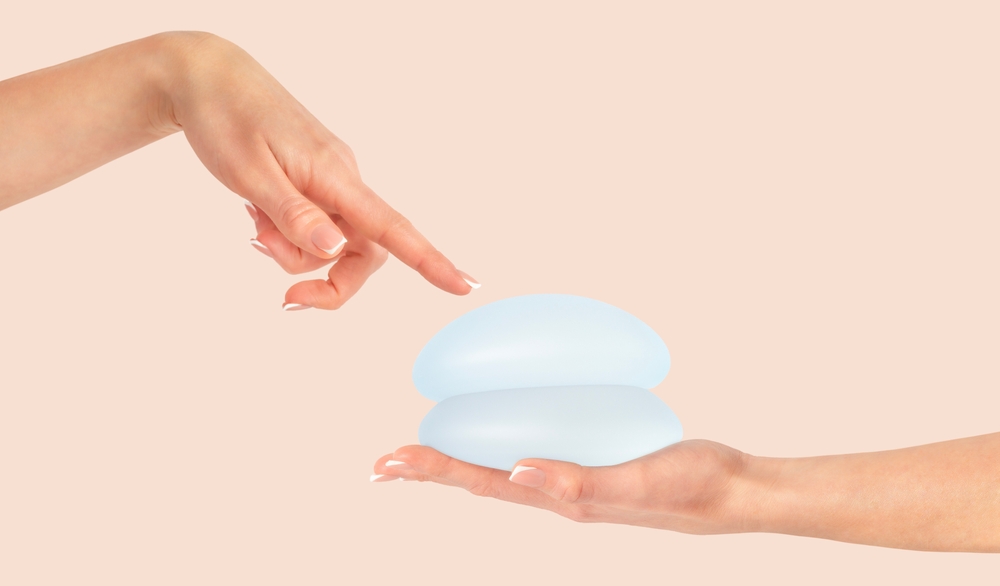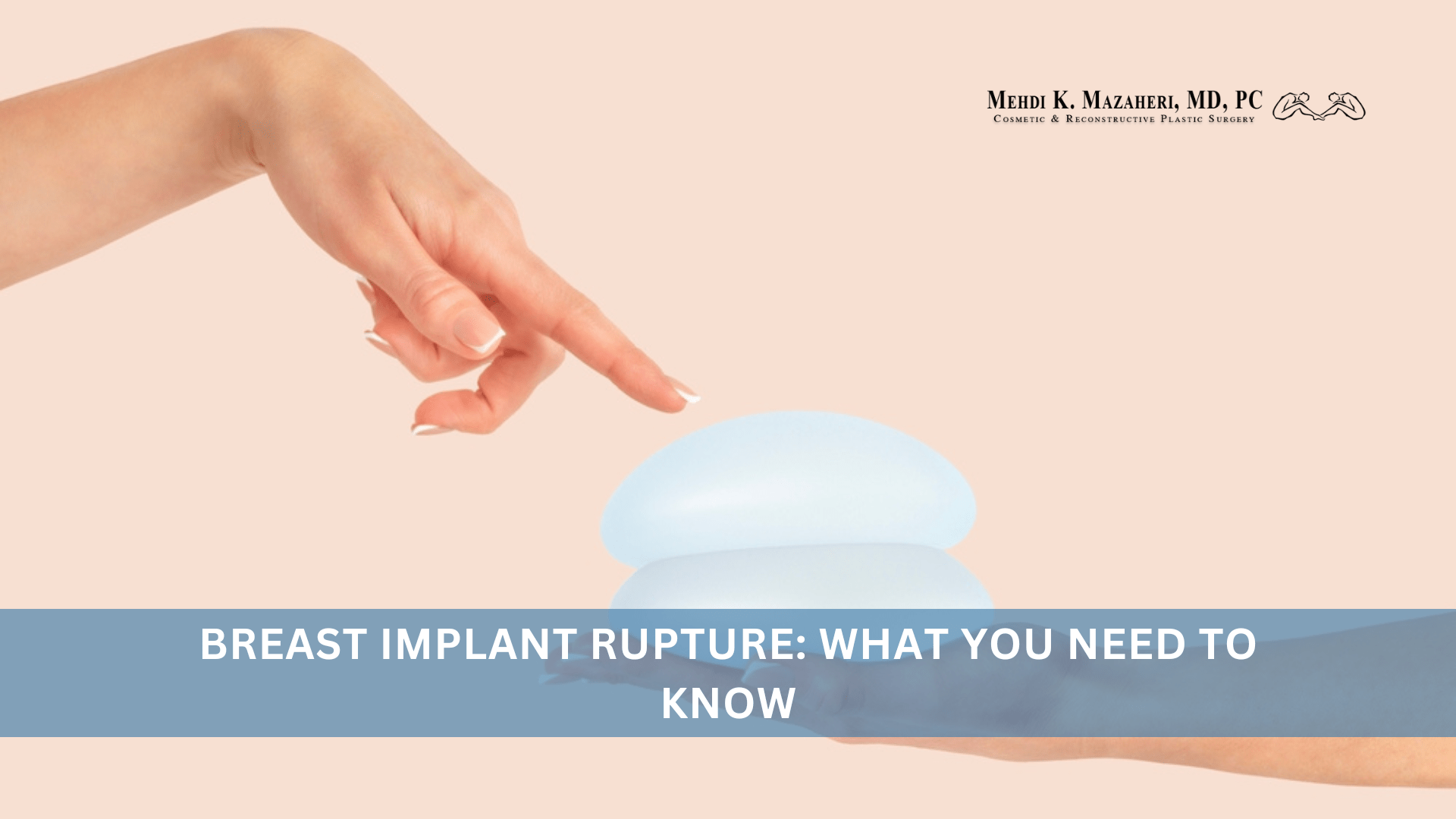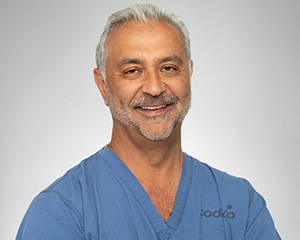Breast enhancement surgery is one of the most common cosmetic procedures with over 3.5 million people in the United States with breast implants. Regardless, breast implants come with risks—including rupture. A breast implant rupture occurs when the outer shell of a saline or silicone implant tears or leaks, allowing the filling to escape or migrate.
Though rupture rates are low, at 1.1% to 17.7 %, it is possible. When weighing your options for breast implants, it is important to speak with your doctor about a variety of topics, including implant rupture potential, implant type, and the lifespan of your implant.
Page Topics
Is Breast Implant Rupture an Emergency?
Despite popular myths, an implant rupture has not been proven to cause cancer. Nevertheless, implant ruptures lead to serious complications.
If you have a ruptured silicone implant you may deal with a variety of health risks, including inflammation, infection, breast scarring, and joint pain. In addition to the side effects, you can experience a decline in aesthetic outcome that causes your breast to deflate and scarring in surrounding tissue.
Understanding Breast Implant Rupture
Breast implant ruptures are often easily detectable during physical examinations. Referred to as a deflated breast, implant ruptures decrease the size of your breast over a period of days. If you have just received implant surgery and are experiencing sudden deflation, it may be a sign that you have iatrogenic damage. In serious cases, it could be indicative of a poorly closed valve.
Types of Ruptures
1. Intracapsular vs. Extracapsular
There are two different types of ruptures and each is categorized based on how far the silicone gel has traveled after a rupture has occurred.
Intracapsular
If your implant ruptures within the fibrous capsule, it is considered an intracapsular rupture. When the shell of the implant breaks, the leaked silicone gel is still contained within the layer of scar tissue that your body naturally forms around any medical implant. You may not notice any change in the shape or feel of the breast because the scar tissue is holding the gel in place. These types of ruptures are almost exclusively found through routine screening during an MRI or specialized ultrasound.
Extracapsular
An extracapsular rupture is more advanced. This occurs when the silicone gel has leaked through both the implant shell and the surrounding fibrous capsule. Once the gel escapes the capsule, it can move into the surrounding breast tissue or, in some cases, travel to the lymph nodes in the armpit. This type of rupture is more likely to cause physical symptoms, such as hard lumps (granulomas) in the breast or underarm or changes in the breast’s contour or size.
2. Silent Rupture
It is common not to notice a silicone-filled breast implant rupture due to the lack of symptoms. That’s because the silicone doesn’t immediately spill out of the implant, unlike saline. When experiencing a “silent rupture,” the shape and feel of your implant will not change, and you may need extensive testing to verify it.
How Each Type Manifests and Its Implications
Though breast implants can last 10 to 15 years, they may need to be replaced before then. The most common cause of premature replacement is external trauma.
All implants have an exterior silicone shell, but this membrane can tear. Many people choose saline implants for added peace of mind knowing if one were to rupture, the saline would be absorbed into the body. Silicone, however, cannot and will not be absorbed into the body.
If the rupture is severe, removing silicone from tissue can be a long and arduous process.

Understanding Breast Implant Rupture
What Causes a Breast Implant to Rupture?
Though most breast implant ruptures occur due to external trauma and injury, there are a handful of other ways damage can happen:
- The longer you have had your breast implants, the more susceptible they are to wear and tear.
- Surgical complications can lead to premature rupture, highlighting the need for an experienced surgeon.
- Implants are developed by manufacturers and—like all products—they can come with defects.
- Certain lifestyle habits can lead to increased risk like smoking and existing medical conditions.
Symptoms of Breast Implant Rupture
Not every breast implant rupture produces obvious changes. When experiencing a “silent rupture”, which is most common with silicone implants, there may not be visible or physical symptoms. That’s why the FDA recommends routine imagining (MRI or ultrasound) to check implant integrity throughout their lifespan.
When symptoms do present, they can include:
- Sudden or gradual breast deflation (more common with saline implants)
- Swelling or tenderness around the breast or chest
- Persistent pain or discomfort
- Tightness or hardening of the breast tissue (capsular contracture)
- Unfamiliar firmness or lumps in the breast or underarm
- Changes in breast size, shape, or symmetry
- Burning, tingling, or numbness near the implant site
Because these signs can overlap with other conditions, it’s important to schedule an evaluation with your plastic surgeon as soon as you notice anything unusual.
Diagnostic Tests
-
Mammography
Though mammogram tests are effective and FDA-approved to test for breast cancer, they may not be the best method for detecting implant ruptures.
-
Ultrasonography
Ultrasound is considered to be a reliable method for detecting rupture in patients under 50 years old. Ultrasonography is often a great addition to MRI testing and is seen as a less invasive method.
-
MRI
Renowned as the most useful imaging method for recognizing breast implant type, MRIs provide accurate testing on implant integrity. As the best test for silicone implants, they’re especially effective when dealing with intracapsular ruptures.
Corrective Surgery for Breast Implant Rupture
When receiving surgery for a breast implant rupture, the implant will be removed and excess silicone leakage will be cleaned up. To make sure that all microscopic silicone pieces are removed, the scar tissue capsule will be taken out before reconstructing the breast.
Treatment Options
1. Implant removal only:
Many people decide to have a breast lift while undergoing breast implant removal surgery. Once the implant is out, the surgeon will remove extra skin and reshape your breast tissue. As a result, the patient will have firmer breasts even without implants.
2. Implant removal and replacement:
Though breast implants last about 10 to 15 years, you’ll likely need a replacement before then if you’ve experienced external trauma and damage. To remove the implant and surrounding hardened tissue, the surgeon will replace the old implant with a new one.
Recovery and Aftercare
Many breast implant rupture surgeries take three hours to complete. The recovery period can last up to six weeks.
During the first two weeks post-surgery, patients will experience swelling and discomfort. The recovery time and ability to get back to regular activities will depend on the individual’s profession. If performing desk work, the patient can return almost immediately but must take periodic breaks to limit excess fluid buildup.
If working a more strenuous job, patients might need to wait two additional weeks after symptoms have subsided.
Prevention and Risk Reduction
1. Choosing the right implant:
To prevent rupture, patients must discuss all options with their surgeon. Implant size, texture, and brand reputation are key features that can impact the success of your breast augmentation. With new advancements in implant technology, your surgeon will help you determine if you are a good fit.
2. Regular monitoring:
To ensure you don’t experience a silent rupture, you should prioritize frequent follow-up appointments with your healthcare provider.
FDA Recommended Screening Schedule
- Years 1 – 4 – Routine self-exams and annual clinical exams with your surgeon.
- Years 5 – 6 – First mandatory screening via Ultrasound or MRI.
- Every 2 – 3 Years – Repeat Ultrasound or MRI for the lifetime of the implant.
Through consistent imaging tests and routine self-exams, you will be able to keep track of your implant’s integrity.
3. Lifestyle factors:
To limit your risk of rupture, there are a variety of lifestyle changes you can make including:
- Maintaining a healthy weight
- Avoiding smoking and drinking excessive alcohol
- Participating in low-impact, safe exercise practices
See Our Successful Breast Augmentation Procedures
Schedule Your Implant Rupture Consultation With Dr. Mazaheri
If you’re interested in learning more about breast enhancement surgery or wanting to schedule an imaging test, schedule an appointment with Dr. Mazaheri, As a premier board-certified plastic surgeon, he will ensure you are educated on the breast implant procedure, common side effects, and adverse reactions to look out for.
Breast Implant Rupture FAQs
What are the symptoms of a breast implant rupture?
Early signs may include breast pain, swelling, or changes in size, shape, or firmness. With saline implants, the breast often deflates quickly. With silicone implants, symptoms may be subtle — sometimes called a “silent rupture” — and only detectable through imaging tests like an MRI or ultrasound.
How long can you leave a ruptured saline implant in place?
A ruptured saline impact can be removed within four weeks of noticeable breast change.
How long can you leave a ruptured silicone implant in place?
If you experience symptoms such as breast tissue hardening, lumps, swelling, or pain, your surgeon will recommend immediate removal.
Can a ruptured implant cause cancer?
Ruptured breast implants are not known to cause breast cancer or any kind of reproductive issues.
Do I need to remove my implants immediately if they rupture?
If you have a ruptured implant and are experiencing uncomfortable side effects, your surgeon will likely recommend surgery within a few weeks.
Is it possible to prevent breast implant rupture completely?
Though you can reduce the risks, it is impossible to prevent breast implants from rupturing.
What should I ask my surgeon about breast implant rupture before getting implants?
Before getting implants, it’s important to have a conversation with your doctor about common risks and complications associated with ruptures and the importance of routine screening.
What should I do if I suspect my implant has ruptured?
Contact your plastic surgeon as soon as possible for an evaluation. Dr. Mazaheri will examine your breast, order the necessary imaging tests, and discuss options for removal or replacement to restore your health and appearance.
Comments are closed.



